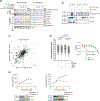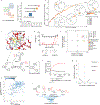SULT1A1-dependent sulfonation of alkylators is a lineage-dependent vulnerability of liver cancers
- PMID: 36914816
- PMCID: PMC11090616
- DOI: 10.1038/s43018-023-00523-0
SULT1A1-dependent sulfonation of alkylators is a lineage-dependent vulnerability of liver cancers
Abstract
Adult liver malignancies, including intrahepatic cholangiocarcinoma and hepatocellular carcinoma, are the second leading cause of cancer-related deaths worldwide. Most individuals are treated with either combination chemotherapy or immunotherapy, respectively, without specific biomarkers for selection. Here using high-throughput screens, proteomics and in vitro resistance models, we identify the small molecule YC-1 as selectively active against a defined subset of cell lines derived from both liver cancer types. We demonstrate that selectivity is determined by expression of the liver-resident cytosolic sulfotransferase enzyme SULT1A1, which sulfonates YC-1. Sulfonation stimulates covalent binding of YC-1 to lysine residues in protein targets, enriching for RNA-binding factors. Computational analysis defined a wider group of structurally related SULT1A1-activated small molecules with distinct target profiles, which together constitute an untapped small-molecule class. These studies provide a foundation for preclinical development of these agents and point to the broader potential of exploiting SULT1A1 activity for selective targeting strategies.
© 2023. The Author(s), under exclusive licence to Springer Nature America, Inc.
Figures


















Comment in
-
Exploiting liver metabolism for tissue-specific cancer targeting.Nat Cancer. 2023 Mar;4(3):310-311. doi: 10.1038/s43018-023-00530-1. Nat Cancer. 2023. PMID: 36977775 No abstract available.
References
Publication types
MeSH terms
Substances
Grants and funding
LinkOut - more resources
Full Text Sources
Medical
Molecular Biology Databases
Research Materials

